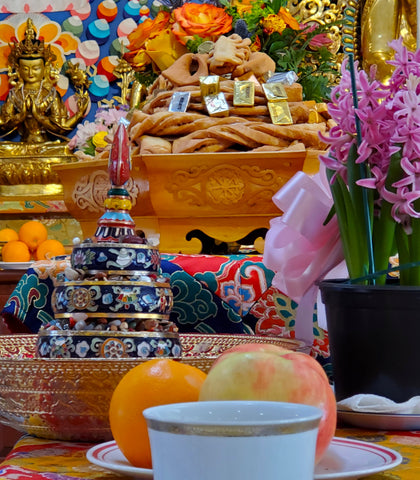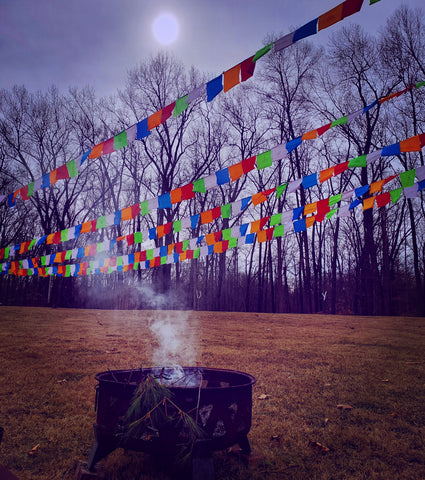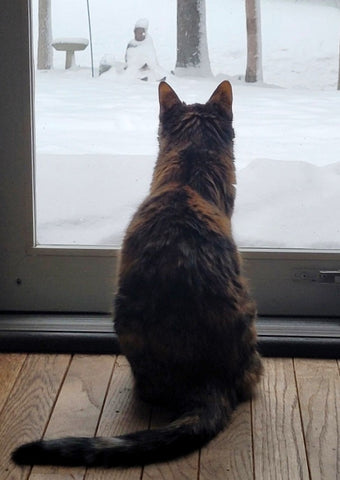News
Peaks and Valleys of Practice: The Flexibility of Familiarity February 26, 2024 18:35

If you prefer to listen to this month's offering, please click HERE for the audio link.
It’s Saturday afternoon, and I’m sitting at a small café table in Barnes and Noble with my daughter. I ordered a cinnamon tea; she ordered a chai latté and we’re splitting an oatmeal raisin cookie. In the background, we can hear the intermittent hiss of the cappuccino machine and the low murmuring of voices at surrounding tables. It’s nice to have time to visit and chat with her. It reminds me of the many hours we enjoyed at Borders years ago—she’d read or work on homework, and I’d grade papers.
February has brought with it many peaks and valleys. Time spent with Elise in a local bookstore is definitely a peak.
Earlier this month, I celebrated Losar, the Tibetan Lunar New Year, with Dharma friends in Bloomington. We celebrated with a purifying smoke puja under freshly hung prayer flags behind the temple. Then, we gathered inside the temple for long life prayers, tea, and sweet rice. Afterwards, we ate lunch in the cultural building and had time to chat with friends.

I enjoyed watching the Tibetan dances, and I especially enjoyed seeing all the little ones in their brocaded chupas and traditional dress. It truly was a wonderful day of celebration and meaningful connection. I didn’t know many of the people who attended; some came from out of state just for this celebration. It didn’t matter—it felt like we were among family members throughout the day. Our love of Tibetan culture and Dharma practice brought us all together. This celebration was definitely a highlight as well.

I am very grateful for having a daily Dharma practice. One of the benefits is that it helps me feel connected to others, even those I’ve never met before, in a meaningful, authentic way. A daily practice definitely helps me appreciate these sweet moments of celebration with others.
However, and probably more importantly, my practice helps me to navigate frustrating times, too. This past week, we had to arrange for our cat, Zora, to have dental surgery. She’s an older kitty, and she takes two different medications to manage seizures and a wonky thyroid. I worry about how she’ll do under anesthesia, as well as her follow-up recovery.
In addition to her health concerns, we had someone randomly cut our phone and internet line. There are several construction projects happening in our area, and our line was cut, which interrupted our phone and internet service for a day or so.
Last Wednesday evening, I was navigating my way through an online chat with a Brightspeed robot on my cell phone to arrange for a technician to come out and trouble shoot our outage. I was also in the process of making dinner. While I was chopping onions, boiling water for pasta, and chatting with a robot, the vet calls on Jim’s cell phone, which he left on the kitchen table while he was outside shooting his bow for archery practice.
So, I’m in the middle of trying to do three important things at the same time. Needless to say, I was a bit flustered and rattled, but I managed to stay relatively calm. I didn’t burn dinner, I was eventually able to schedule and confirm a tech visit, and the vet patiently repeated her instructions so that I could clearly process what she was saying.
Afterwards, when things settled down, I looked forward to my practice. During stressful and chaotic times, it helps me to stay calm and steady. The familiarity of the practice is soothing and comforting, and it helps me to focus on something positive.
Later in the week, during the Sunday Dharma teaching in Bloomington, Minyak Rinpoche said something that really resonated with me. He said, “Everything depends upon the flexibility of familiarity.”
In other words, having a daily practice to rely on helps foster a flexible mindset. I have definitely found that a daily practice helps me to navigate unexpected pivots and surprises. It offers a steady foundation in the face of constant change.
I’ve also noticed that it’s during stressful times when I realize how well my practice is actually serving me (and others). It’s also during these chaotic times that I learn how effectively, and mindfully my practice has been. Stressful times also reveal where my weak spots are—and in what areas I still need to grow.
Am I just saying the words and going through the motions of the practice? Or, am I taking enough time to contemplate and analyze the meaning of what I’m reading or saying? Most importantly, am I applying what I’m practicing to my everyday life?
If I can remain calm during challenging times, and in the aftermath of challenging times, I know I’m on the right path. If I get agitated and flustered, I know I have work to do.
Last night, I spent over an hour in the kitchen tending to Zora—encouraging her to eat her food. It’s a slow process. She takes a few bites, then walks away. She comes back around to take another bite, then walks away again. If I walk away, she won’t eat at all, but if I stay in the kitchen, she’ll keep returning.
We have to keep a close eye on Maya, our Yorkie, who is more than happy to eat her food, and doesn’t care that it’s laced with medications that she does not need.
During this hour, I wasn’t stressed. I was present, patient, and calm. I made dinner. I washed dishes. I listened to the news. In between, I pushed her food into a small pile on her plate to entice her to continue eating. This pile slowly dwindled over the course of the hour.
Afterwards, when she finally finished her food, I felt emotionally drained, stressed, and scared. My anxieties about her upcoming surgery resurfaced. I wound up snapping at Jim and stomped upstairs to stress-vacuum the floor.
This is how I know I need to continue to practice—and that I need to continue to fine-tune my practice. I’m currently able to stay fairly steady and calm in the middle of the chaos, but not after the chaos has passed.
Moments like these make me realize how important it is to take quality time--
to sit on my cushion and meditate,
to mindfully recite mantra,
to read Dharma texts or listen to Dharma talks,
and to engage is some kind of purification practice
EVERY DAY!!!!
Moments like these help me recognize the progress I’ve already made, and I have made slow, steady progress, much like Zora returning to her dwindling plate of food in the kitchen. These moments help me to appreciate how much I’ve changed for the better, and they also motivate and encourage me to continue to keep practicing in order to move forward on the path.

I hope that you are navigating all of the peaks and valleys of your life with skill, grace, courage, and patience. If a beautiful, hand-knotted mala would enhance and inspire your practice, please visit the MMM online shop. Send me a message via the Contact Us page if you are interested in a custom design. I’d be happy to create a beautiful mala or quarter mala design that’s just right for you and your practice.
One Breath, One Bead at a Time. July 4, 2016 16:04
The Zombie Apocalypse is real. For 25 years, I taught high school English. For many of those years, I felt trapped in a perpetual cycle of planning lessons, creating tests and essay assignments, grading papers, and attempting to manage and meet the academic needs of students crammed in over-crowded classrooms. I often felt confined by the clock and by the ever-present and perpetually-increasing demands that a data-driven system thrives on—the almighty standardized test scores.
I felt stressed—all the time—and I spent very little time in the present moment. This constant striving, doing, rushing, pushing, and grasping for the future or ruminating and worrying about the past kept me from meeting the needs of my students and taking care of myself. It also kept me out of the present moment, and it prevented me from enjoying my life. My students never really knew who I was—and neither did I.
For a quarter of a century, I was caught up in a trance, and yoga and meditation gradually helped me break the spell and encouraged me to find balance and purpose in my life.
My first experience with yoga and meditation occurred when I was a freshman at Butler. A guest speaker came to our Physical Education/Health class. My fellow classmates and I were crammed into a small classroom/storage room, and many of us giggled our way through the guided meditation followed by a brief asana practice in the gym. This was not an ideal environment to explore the benefits of meditation and yoga, and it certainly didn’t leave a lasting or accurate impression on me.
I revisited meditation when I was pregnant with my daughter in 1994, and in 2000, started regularly attending a yoga class at a local gym. Progress was glacially slow—but gradually, very gradually, I started to find a respite from the 10,000 distractions and thoughts that blocked my path, and I started to connect and reconnect with myself.
Stilling the constant mental chatter in meditation was a big challenge in the beginning—and still can be at times, even now. But with consistent practice, and, ideally, after an hour of asana practice, it’s much easier to climb inside the present moment. Memories, thoughts, and feelings still rise to the surface, but it’s easier now to briefly acknowledge them, allow them to drift away in order to make room for the spaces between thoughts.
Yoga, too, has helped. It has helped me focus on my breathing—and to bring my awareness out of the mind and into the body—even for just a little while. Yoga also allows me to sit more comfortably when I’m meditating—and to sit for longer periods of time.
In recent years, I have added a mantra practice with malas to enhance my meditation and yoga practice. Using a mala gives me a tactile anchor that keeps me rooted and grounded in the here and now. Each bead becomes a fresh focal point, a new beginning, ushering in a new moment. Each inhalation, each exhalation, each repetition of the mantra welcomes now, and now, and now.
Ultimately, my yoga and meditation practice has saved my life—it has helped me find balance and perspective, and it has prevented me from falling off the precipice of perpetual busyness and disappearing into the abyss of the living dead.
I’ve since retired from teaching full-time. I still tutor part-time, and working with students one-on-one allows me to give them my undivided attention—to be fully present. I also teach and practice yoga, and along with running a small business, I still remain very busy, but I am no longer a slave to busyness. I am living my life on my own terms, and I am living my life one moment at a time—one bead at a time.

